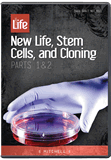Blob or Baby?
Originally published in Creation 25, no 1 (December 2002): 20-21.
Is a five-day-old embryo a “ball of cells” or a human being?
Governments around the world are wrestling with the controversial issue of embryonic stem cell research. The Australian Government’s controversial support for such research is based on the (mis)understanding that a 5-day-old embryo is a “ball of cells … not a human being”.1 This is a widely held view in the scientific world and would appear to give rational, if not moral, support for the government’s policy. But not any more.
The “ball of cells” concept is that the embryo is undifferentiated; that is, all the cells are the same and no individual cells have yet been assigned their final destinations to become skin, hair, bone, blood, etc. Evidence supporting this view includes the fact that the embryo can be divided to produce multiple identical babies (twins, triplets, etc.), and one or two cells can be removed from the “ball” for genetic screening without apparent ill-effect. But all this has now changed.
Identical twins and embryo research
Some have claimed that it is ethical to research embryos up to 14 days, because there is the possibility of forming identical twins. Therefore, they claim, it is illogical to regard an embryo as an individual if it could still become two people. Such claims are sometimes supported by claiming that a minority of Roman Catholic philosophers allegedly reason that a soul could not enter an embryo that still had the capacity to divide in two.
But this is fallacious, for two reasons. First, we cannot decide scientifically how or when a soul enters an embryo. Second, the personhood of a 15-day embryo is established by the claimants’ own admission. If it happens to divide into identical twins prior to that, then the personhood of the twins on day 15 in no way invalidates the personhood of the previously undivided embryo. It would simply be a form of asexual human reproduction.
Scanning Electron Micrograph
When the egg has been fertilized, the resulting zygote (fertilized egg) begins to grow by dividing. The outer membrane (zona pellucida) of the embryo is absent. This 10-cell stage represents day 3 of embryo development.
Recent research has found that differentiation of the embryonic cells begins on the day of conception and may even be initiated by the point of entry of the sperm into the egg.2 When egg and sperm unite, they produce a single new cell, called the “zygote”, and the zygote is the first cell in the body of the new baby. When the zygote undergoes its first cell division to produce a two-celled embryo, it now appears that these two cells form the top-tail axis for all subsequent development. In other words, which part will be the head, for instance, is determined “up front”. And similar processes of orientation appear to continue during all subsequent cell divisions.
The research has been in progress for more than a decade and early results that pointed in this direction were originally met with some hostility. Many people did not want to know that the early embryo may not be “just a featureless blob of cells”. Why? Perhaps it reminded them that their experiments were dismembering a tiny person already in the process of formation.3
Much work remains to be done to clarify the details, but it is certainly now clear that developmental biologists can no longer talk about the early embryo being a featureless blob of cells.
But what about the evidence cited earlier supposedly supporting the “blob” theory? It has been suggested that perhaps damage control mechanisms in the embryo are powerful enough to overcome the impact of early cell loss. If this is true, then it does not negate the new findings, it simply underlines the fact that any such manipulations do cause damage to the embryo, and those who cause them need to take responsibility for their actions. (See box to the right regarding the “twins” argument.)
Where does this leave the Australian government policy on embryonic stem cell research? It will certainly give the opponents of embryo experimentation a new weapon but it probably won’t change anything immediately because the Australian research will be carried out on unused IVF embryos that would otherwise be thrown out. This “lesser of two evils” ethical argument will probably carry the day. When that supply runs out they expect to use donated embryos.4 So for the present, the issue comes down to a personal question: “Would you donate your embryonic children?”5
Footnotes
- Mallabone, M., Vanstone [Federal Government Minister] firm on cell research, The West Australian, 6 July 2002, p. 13.
- Pearson, P., Your destiny, from day one, Nature Science Update, 8 July 2002.
- Pro-abortionists would also prefer to hold the embryo to be as “less than human” as possible at any stage.
- Mallabone, M., Vanstone [Federal Government Minister] firm on cell research, The West Australian, 6 July 2002, p. 13.
- See also <https://answersingenesis.org/sanctity-of-life/>.
Recommended Resources

Answers in Genesis is an apologetics ministry, dedicated to helping Christians defend their faith and proclaim the good news of Jesus Christ.
- Customer Service 800.778.3390
- © 2025 Answers in Genesis




